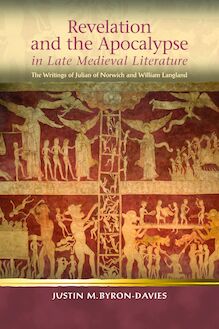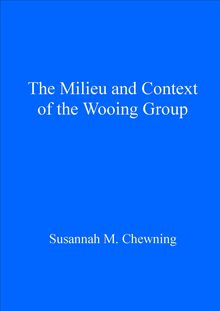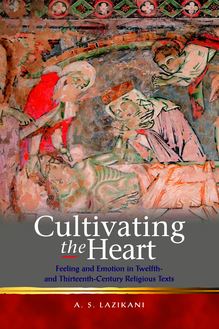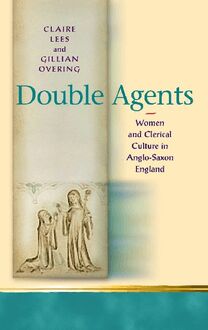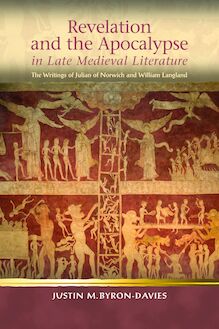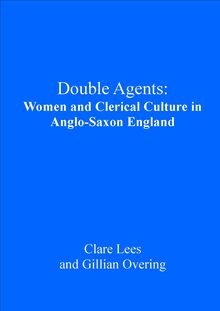Cultivating the Heart , livre ebook
177
pages
English
Ebooks
2015
Obtenez un accès à la bibliothèque pour le consulter en ligne En savoir plus
Découvre YouScribe et accède à tout notre catalogue !
Découvre YouScribe et accède à tout notre catalogue !
177
pages
English
Ebooks
2015
Obtenez un accès à la bibliothèque pour le consulter en ligne En savoir plus
Publié par
Date de parution
15 juin 2015
Nombre de lectures
3
EAN13
9781783162659
Langue
English
Poids de l'ouvrage
3 Mo
Cultivating the Heart examines the nurturance of feeling – especially the intertwined affective stirrings of compassion, love, and sorrow – in a range of religious texts from the twelfth and thirteenth centuries. These texts encourage, stimulate, define and attempt to express the ‘cultivation of hearts’, an image inspired by Part VII of Ancrene Wisse, whereby readers and audiences of the texts nurture a range of sophisticated ‘affective literacies’. In addition to extensive analysis of English, Latin and Anglo-Norman texts, this book makes substantial reference to the affective strategies of wall paintings in parish churches, demonstrating how the affective strategies of wall paintings cannot be perceived as inferior to or irreconcilable with the affective import of textual media.
Introduction
Chapter 1: Upon a Spiritual Cross: Feeling in the Lambeth and Trinity Homilies
Chapter 2: The Gnawed Hand: Presence and Absence of Feeling in the Early South English Legendaries
Chapter 3: Co-feeling: Compassion in Ancrene Wisse and the Wooing Group
Chapter 4: Call Me Bitter: Feeling and Sensing in Passion Lyrics
Conclusion
Publié par
Date de parution
15 juin 2015
EAN13
9781783162659
Langue
English
Poids de l'ouvrage
3 Mo
RELIGION AND CULTURE IN THE MIDDLE AGES
Cultivating the HeartSeries Editors
Denis Renevey (Université de Lausanne)
Diane Watt (University of Surrey)
Editorial Board
Miri Rubin (Queen Mary University of London)
Jean- Claude Schmitt (École des Hautes Études en Sciences Sociales, Paris)
Fiona Somerset (Duke University)
Christiania Whitehead (University of Warwick)RELIGION AND CULTURE IN THE MIDDLE AGES
Cultivating the Heart
FEELING AND EMOTION IN TWELFTH- AND
THIRTEENTH-CENTURY RELIGIOUS TEXTS
A. S. LAZIKANI
UNIVERSITY OF WALES PRESS
2015$
D
Z
E
© A. S. Lazikani, 2015
All rights reserved. No part of this book may be reproduced in any material form
(including photocopying or storing it in any medium by electronic means and whether
or not transiently or incidentally to some other use of this publication) without the
written permission of the copyright owner. Applications for the copyright owner’s
written permission to reproduce any part of this publication should be addressed to the
University of Wales Press, 10 Columbus Walk, Brigantine Place, Cardiff CF10 4UP.
www.uwp.co.uk
British Library CIP Data
A catalogue record for this book is available from the British Library.
ISBN 978-1-78316-261-1 (hardback)
978-1-78316-264-2 (paperback)
e- ISBN 978-1-78316-265-9
asserted in accordance with sections 77 and 79 of the Copyright, Designs and Patents
Act 1988.
Typeset by Eira Fenn Gaunt, Pentyrch, Cardiff
Printed by CPI Antony Rowe, Chippenham, Wiltshire
EHHQ KDV RUN WKLV RI RI ULJKW 7KH DXWKRU VLGHQWL¿HG H WR/D]LNDQL6DUPDGD \RXVKCONTENTS
Series Editors’ Preface vii
List of Illustrations ix
Acknowledgements xi
List of Abbreviations xiii
Note on Editions and Translations xv
Introduction: Feeling in the High Middle Ages 1
1 Upon a Spiritual Cross: Feeling in the Lambeth and Trinity Homilies 25
2 The Gnawed Hand: Presence and Absence of Feeling in the Early South
English Legendaries 49
3 Co-feeling: Compassion in Ancrene Wisse and the Wooing Group 71
4 Call Me Bitter: Feeling and Sensing in Passion Lyrics 93
Conclusion 121
Notes 125
Select Bibliography 149
Index 153 UROHV
V
Z
E
RZQHUV
H
E\
P
W
Q
RI
:
UHDGHUV
KH
W
S
WKDQ
IXUWKHU
W
W
RGHUQ
L
FLSOLQHV
W
D
ERRNV
W
F
L
W
W
DQG
V
DXWKRUV
Z
D
Z
ZRPHQ
D
OD\HG
H
D
U
WKH
Z
H[SORUH
G
R
Z
ZDQW
D
R
W
L
I
G
G
F
SERIES EDITORS’ PREFACE
Religion and Culture in the Middle Ages aims to explore the interface between medieval
religion and culture, with as broad an understanding of those terms as possible. It puts
WR KH IRUHIURQW WXGLHV KLFK QJDJH LWK RUNV KDW VLJQL¿FDQ WO\ RQWULEXWHG R WKH
shaping of medieval culture. However, it also gives attention to studies dealing with
KD FXOWXUH PHGLHYDO RI VSHFWV KLJKOLJKW DQG UHÀHFW KDW ZRUNV Q HJOHFWHG HHQ KDYH W
the past by scholars of the medieval disciplines. For example, devotional works and the
practice they infer illuminate our understanding of the medieval subject and its culture
in remarkable ways, while studies of the material space designed and inhabited by
medieval subjects yield new evidence on the period and the people who shaped it and
DOV ZH FXOWXUH DQG UHOLJLRQ RI ¿HOG JHU ODU WKH ,Q LW Q OLYHG
WKHP GH¿QLQJ WKHUHE\
PRUH SUHFLVHO\ V DFWRUV Q WKH FXOWXUDO ¿HOG 7KH VHULHV V D ZKROH LQYHVWLJDWHV WKH
European Middle Ages, from c.500 to c.1500. Our aim is to explore medieval religion
and culture with the tools belonging to such disciplines as, among others, art history,
philosophy, theology, history, musicology, the history of medicine, and literature. In
particular, we would like to promote interdisciplinary studies, as we believe strongly
that our modern understanding of the term applies fascinatingly well to a cultural period
LV LWV RI FDWHJRUL]DWLRQ DQG RQ¿QHPHQW WLJKW OHVV D E\ PDUNHG
period. However, our only criterion is academic excellence, with the belief that the use
of a large diversity of critical tools and theoretical approaches enables a deeper
XQGHUVWDQGLQJ RI PHGLHYDO FXOWXUH DQW WKH VHULHV R UHÀHFW KLV GLYHUVLW\ DV H
believe that, as a collection of outstanding contributions, it offers a more subtle
representation of a period that is marked by paradoxes and contradictions and which
QHFHVVDULO\ HÀHFWV LYHUVLW\ QG HUHQFH GLI KRZHYHU LI¿FXOW LW PD\ VRPHWLPHV KDYH
proved for medieval culture to accept these notions.ILLUSTRATIONS
1 Passion Cycle on East Wall in St Mary’s Church, Brook, Kent (c.1260–80)
2 Passion sequence on South Wall in St Michael’s Church, Great Tew, Oxfordshire
(c.1290)
3 Wall of the nave of St Mary’s Church, West
Chiltington, Sussex (c.1250–75)
4 Detail of the Passion sequence in St Michael’s Church, Great Tew, Oxfordshire
(c.1290): ‘Noli me tangere’
All photographs are the author’s own. The approximate dates follow those given by
Anne Marshall in her ‘Painted Church’ project: <www.paintedchurch.org/> (accessed
June 2013).K
H
V
F
ACKNOWLEDGEMENTS
I am very grateful to many eminent scholars and editors for their generous interest in
and feedback on this book as it has developed.
Most of all, I am very grateful to Dr Annie Sutherland for investing a great deal of her
time reading through my work and offering so much invaluable feedback, both as my
doctoral supervisor and in subsequent years. No student could have had a more caring
or inspiring supervisor.
Professor Vincent Gillespie and Professor Elizabeth Robertson also invested much of
their time as my doctoral examiners reading and correcting material that is now in this
book. I very much appreciate the wealth of feedback they have given me, and all their
kindness and encouragement both as my examiners and in subsequent years.
I am grateful to Professor Denis Renevey for his generous interest in this project and
for all his many stimulating suggestions, and to Dr Helen Barr for her supportive and
thoughtful comments on my work. Professor Bella Millett has taken the time to kindly
answer my many queries on homilies, and I thank also the anonymous reader of my
manuscript at the University of Wales Press for her valuable suggestions.
Dr Liz Herbert McAvoy and Dr Catherine Innes-Parker have, as always, shown me
great kindness, and Dr Alexandra Da Costa and Dr Aditi Nafde have been so encouraging.
I would also like to thank Dr Tony Hunt and Dr Jane Bliss for their very useful input on
Anglo-Norman texts.
In its earlier stages as a doctoral thesis, this project was funded by the Arts and
Humanities Research Council, and I am grateful to the AHRC for making this initial
research possible.
Thank you very much to Bertie and Bissan for advice about photographing church
wall paintings. I am so grateful to Maria for reading over parts of this book carefully, and
for all her warm encouragement over the past years. And thank you so much to Sabina
for all her support and friendship through this project’s development.
This book is dedicated to the memory of my mother, Amal, and to my father, Muhydin
YHU EH XI¿FLHQW ± IRU HYHU\WKLQJ WKH\ DYH GRQH DQG IRU ZKLFK QR ZRUGV RXOG
ABBREVIATIONS
AASS Acta Sanctorum quotquot tot orbe coluntur, vel à Catholicis
Scriptoribus celebratur, ed. Jean Bolland et al., 68 vols
(Brussels: Alphonsum Greise, 1863–1940)
EETS Early English Text Society (1864–)
O. S. Original Series (1864–)
E. S. Extra Series (1867–1920)
S. S. Supplementary Series (1970–)
MED Middle English Dictionary, ed. by Hans Kurath and S. M. Kuhn
(Ann Arbor: University of Michigan Press; London: Oxford
University Press, 1952–)
Online version (Michigan, 18 December 2001): <http://quod.lib.umich.
edu/m/med/>
PL Patrologiae cursus completus: series Latina, ed. by J. P. Migne,
221 vols (Paris: Migne, 1844–55 and 1862–5)
SEL South English Legendaries
NOTE ON EDITIONS AND TRANSLATIONS
Biblical References
Due to considerations of space, biblical references in most cases are to the
DouayRheims translation, and not to the original Latin Vulgate (The Holy Bible, Douay
Version: Translated from the Latin Vulgate (Douay, AD 1609: Rheims, AD 1582).
London: Catholic Truth Society, 1956).
Editions of Middle English
All quotations are taken from the following editions:
I The Lambeth and Trinity Homilies
Lambeth homilies:
Old English Homilies, First Series, ed. Richard Morris, EETS O. S. 29, 34 (London,
1867–8).
Trinity homilies:, Second Series, ed. Richard Morris, EETS O. S. 53 (London,
1873).
Punctuation has been modernized.
II South English Legendaries
The Early South-English Legendary, or, Lives of Saints, ed. Carl Horstmann, EETS O. S.
87 (London, 1887).
III Ancrene Wisse and the Wooing Group
Ancrene Wisse: A Corrected Edition of the Text in Cambridge, Corpus Christi College,
MS 402 with Variants from Other Manuscripts, ed. Bella Millett, 2 vols, EETS O. S. 325
and 326 (Oxford, 2005–6).
Þe Wohunge of ure Lauerd, etc., ed. W. Meredith Thompson, EETS O. S. 241 (London,
1958).
Given the heavily diplomatic nature of Thompson’s edition, the texts have been
re-edited from the manuscripts, but page numbers to Thompson’s edition are given for
the reader’s convenience. Abbreviations (with the exception of the Tironian nota) are xvi NOTE ON EDITIONS AND TRANSLATIONS
expanded, word-spacing is modernized, ‘wynn’ is rendered ‘w’, and interlinear or
marginal insertions in the manuscripts are also made silently. Obvious scribal errors –
typically eth for ‘d’, and thorn for ‘b’ – are corrected without comment. Semicolons
stand for the punctus elevatus.
IV Middle English Lyrics
English Lyrics of the Thirteenth Century, ed. Carleton Brown (Oxford, 1932). ‘Wynn’ in
Brown’s edition is reproduced as ‘w’, but ‘thorn’ and ‘eth’ are preserved.
Other editions have been consulted in conjunction with Brown’s work, as will be
referenced in the book.
Translations
In order to maintain consistency in terminology for affective stirrings, I have provided
my own tran
